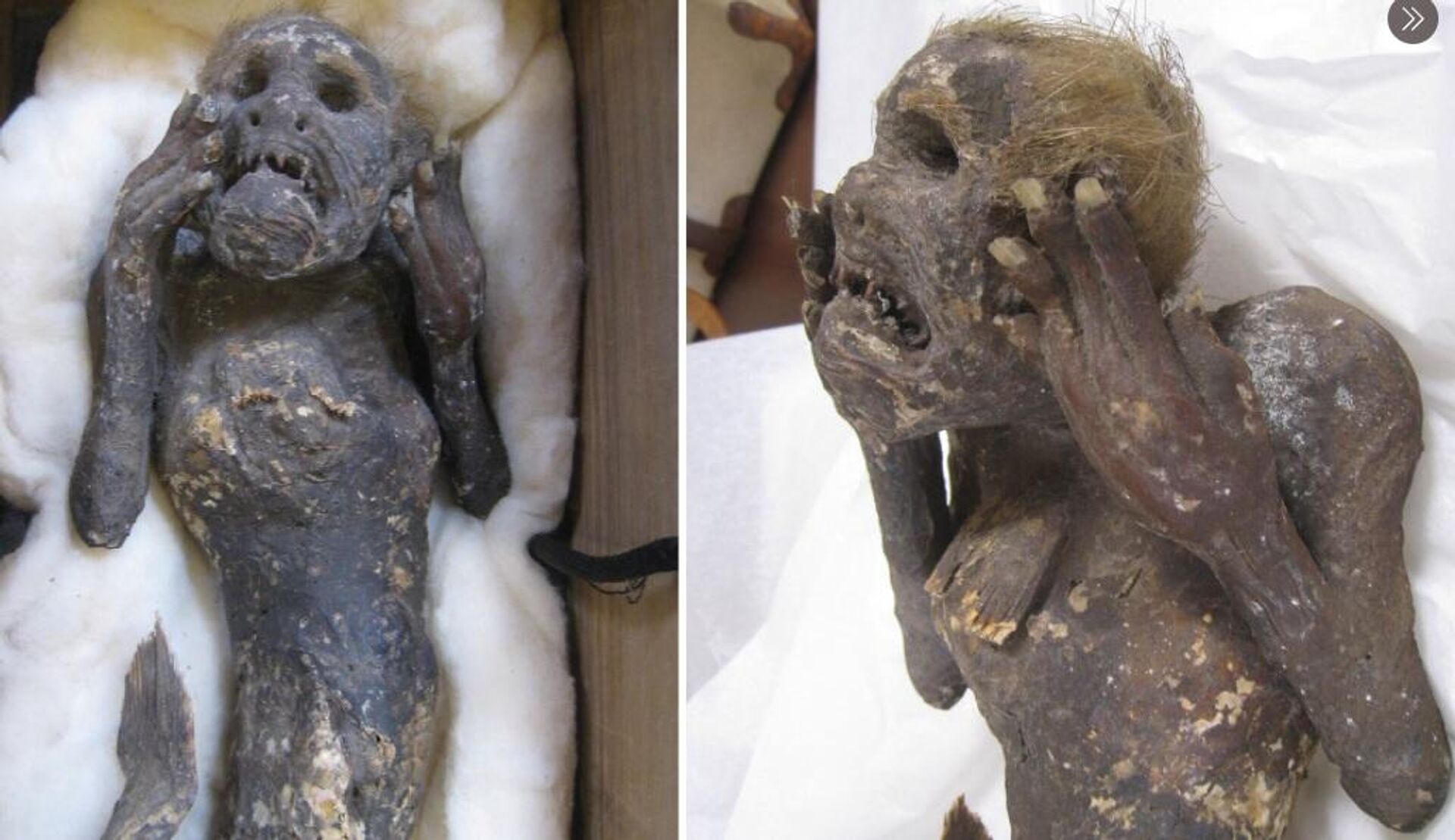https://sputnikglobe.com/20220304/scientists-try-to-uncover-mystery-of-mummified-mermaid-that-can-grant-immortality-media-says-1093573631.html
Scientists Try to Uncover Mystery of Mummified Mermaid That 'Can Grant Immortality', Media Says
Scientists Try to Uncover Mystery of Mummified Mermaid That 'Can Grant Immortality', Media Says
Sputnik International
According to Japanese media, the enigmatic creature was discovered in the Pacific Ocean off the island Shikoku between 1736 and 1741.
2022-03-04T06:33+0000
2022-03-04T06:33+0000
2022-03-04T06:33+0000
japan
mummy
mermaiding
legends
folklore
immortality
https://cdn1.img.sputnikglobe.com/img/105649/94/1056499477_0:161:3071:1888_1920x0_80_0_0_eee37c2616f38eb3a260e6d49798eb0a.jpg
A group of Japanese scientists are trying to uncover the mystery of a "mummified mermaid" that can supposedly "grant immortality", Asahi Shimbun has reported. According to the newspaper, researchers from the Kurashiki University of Science and the Arts plan to take a CT scan of the mysterious creature.Researchers say the creature is around 300 years old and resembles something known as a ningyo, which is described as half-monkey, half-fish.The bizarre figure has been kept in a temple in the city of Asakuchi, where it once was on display. According to chief priest Kozen Kuida, the mermaid was worshipped at the temple during the COVID pandemic. Per one Japanese legend, a mermaid predicted an infectious disease. People in the temple hoped that worshipping the enigmatic creature would help "alleviate the coronavirus pandemic", said chief priest Kozen Kuida.Hiroshi Kinoshita has a more practical interest in the figure. He doesn't believe in mythical creatures and believes the mummified mermaid was manufactured at some point during the Edo period of Japan's history, between 1603 and 1867.Researchers say they will publish the first results of their study later this year.
japan
Sputnik International
feedback@sputniknews.com
+74956456601
MIA „Rosiya Segodnya“
2022
News
en_EN
Sputnik International
feedback@sputniknews.com
+74956456601
MIA „Rosiya Segodnya“
Sputnik International
feedback@sputniknews.com
+74956456601
MIA „Rosiya Segodnya“
the city of asakuchi, mummified mermaid, uncover the mystery of, can grant immortality, the coronavirus pandemic, according to a legend,
the city of asakuchi, mummified mermaid, uncover the mystery of, can grant immortality, the coronavirus pandemic, according to a legend,
Scientists Try to Uncover Mystery of Mummified Mermaid That 'Can Grant Immortality', Media Says
According to Japanese media, the enigmatic creature was discovered in the Pacific Ocean off the island of Shikoku between 1736 and 1741. It is now kept in a temple in the city of Asakuchi in a fireproof safe along with a letter reportedly written by its previous owner.
A group of Japanese scientists are trying to uncover the mystery of a "mummified mermaid" that can supposedly "grant
immortality",
Asahi Shimbun has reported. According to the newspaper, researchers from the Kurashiki University of Science and the Arts plan to take a CT scan of the
mysterious creature.
"Japanese mermaids have a legend of immortality. It is said that if you eat the flesh of a mermaid, you will never die. There is a legend in many parts of Japan that a woman accidentally ate the flesh of a mermaid and lived for 800 years", said Hiroshi Kinoshita of the Folklore Society, who came up with the idea of studying the mummified mermaid.
Researchers say the creature is around 300 years old and resembles something known as a ningyo, which is described as half-monkey, half-fish.
The bizarre figure has been kept in a temple in the city of Asakuchi, where it once was on display. According to chief priest Kozen Kuida,
the mermaid was worshipped at the temple during the COVID pandemic. Per one Japanese legend, a mermaid predicted an infectious disease. People in the temple hoped that worshipping the enigmatic creature would help "alleviate the coronavirus pandemic", said chief priest Kozen Kuida.
Hiroshi Kinoshita has a more practical interest in the figure. He doesn't believe in mythical creatures and believes the mummified mermaid was manufactured at some point during the Edo period of Japan's history, between 1603 and 1867.
"I think it is made from living animals and we would like to identify them by CT scans or DNA testing. It looks like a fish with scales on the lower body and a primate with hands and a face on the upper body", Hiroshi Kinoshita said.
Researchers say they will publish the first results of their study later this year.




